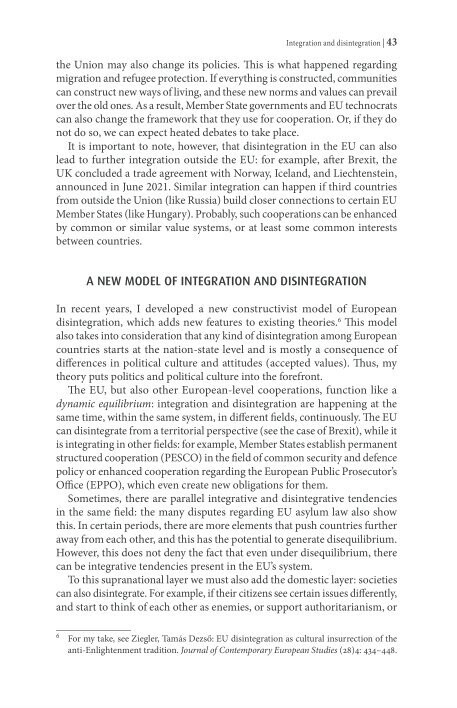
Page 45 [45]

OCR
Integration and disintegration | 43 the Union may also change its policies. This is what happened regarding migration and refugee protection. If everything is constructed, communities can construct new ways of living, and these new norms and values can prevail over the old ones. Asa result, Member State governments and EU technocrats can also change the framework that they use for cooperation. Or, if they do not do so, we can expect heated debates to take place. It is important to note, however, that disintegration in the EU can also lead to further integration outside the EU: for example, after Brexit, the UK concluded a trade agreement with Norway, Iceland, and Liechtenstein, announced in June 2021. Similar integration can happen if third countries from outside the Union (like Russia) build closer connections to certain EU Member States (like Hungary). Probably, such cooperations can be enhanced by common or similar value systems, or at least some common interests between countries. A NEW MODEL OF INTEGRATION AND DISINTEGRATION In recent years, I developed a new constructivist model of European disintegration, which adds new features to existing theories.* This model also takes into consideration that any kind of disintegration among European countries starts at the nation-state level and is mostly a consequence of differences in political culture and attitudes (accepted values). Thus, my theory puts politics and political culture into the forefront. The EU, but also other European-level cooperations, function like a dynamic equilibrium: integration and disintegration are happening at the same time, within the same system, in different fields, continuously. The EU can disintegrate from a territorial perspective (see the case of Brexit), while it is integrating in other fields: for example, Member States establish permanent structured cooperation (PESCO) in the field of common security and defence policy or enhanced cooperation regarding the European Public Prosecutor’s Office (EPPO), which even create new obligations for them. Sometimes, there are parallel integrative and disintegrative tendencies in the same field: the many disputes regarding EU asylum law also show this. In certain periods, there are more elements that push countries further away from each other, and this has the potential to generate disequilibrium. However, this does not deny the fact that even under disequilibrium, there can be integrative tendencies present in the EU’s system. To this supranational layer we must also add the domestic layer: societies can also disintegrate. For example, if their citizens see certain issues differently, and start to think of each other as enemies, or support authoritarianism, or ° For my take, see Ziegler, Tamäs Dezsö: EU disintegration as cultural insurrection of the anti-Enlightenment tradition. Journal of Contemporary European Studies (28)4: 434-448.
structurelles
Custom
Image Metadata
- Largeur de l'image
- 1830 px
- Hauteur de l'image
- 2834 px
- Résolution de l'image
- 300 px/inch
- Taille du fichier d'origine
- 1.2 MB
- Lien permanent vers jpg
- 022_000045/0044.jpg
- Lien permanent vers OCR
- 022_000045/0044.ocr
